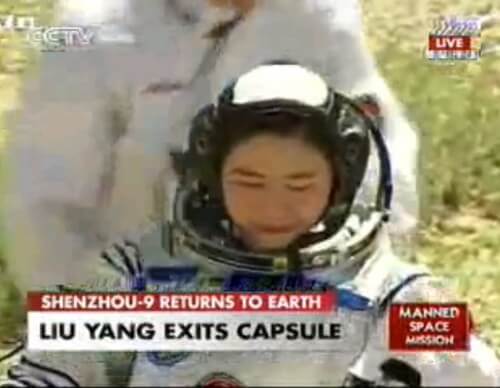The team members performed a 13-day mission in which they achieved a manual docking capability with the Tiangong 1 Space Laboratory and performed a series of experiments. The team included the first Chinese space squadron Liu Yang and together with her the commanding officer Jing Haifeng and Liu Wang

The Chinese spacecraft Shenzhou 9 and its three crew members returned to Earth in their capsule in Central Mongolia this morning at 02:05 GMT (05:05 Israel time).
While in space, the team members managed to complete a 13-day mission, in which they achieved the ability to manually dock with the Tiangong 1 Space Laboratory and performed a series of experiments. The team consisted of the first Chinese space squadron Liu Yang and together with her the commanding officer Jing Haifeng and Liu Wang.
The Chinese space agency said the mission is a big step towards building a permanent space station in 2020.
The spacecraft was launched on June 16 and docked at the space station automatically on June 18. Team members worked and lived in the Tiangong 1 module for several days and performed medical experiments as well as studies with live butterflies, butterfly eggs and pupae. Later they left the station and returned to it with manual docking, an important experiment that will be used in the event of a malfunction in the automatic systems. While Russia and the USA performed manual docking back in the sixties, it is still considered a complicated maneuver, in which two vehicles moving at a speed of thousands of km/h are brought together and connected.
http://www.youtube.com/watch?v=0dnARfUwWgA
The Tiangong-1 spacecraft, which weighs 8.5 tons, is supposed to stay in space for at least two years and support crews of up to three astronauts for a short time. One manned mission is planned to reach it - Shenzhou 10.
The planned space station will weigh 60 tons and will be about one-sixth the size of the International Space Station, meaning it will be slightly smaller than Skylab.
China launched the first Techonaut in 2003, two Techonauts together in 2005 and three in 2008, in the mission that carried out China's first spacewalk. A document revealed in December described China's ambitious space program "will carry out a series of preliminary plans for a manned landing on the moon." said the document.

7 תגובות
You can read in the autobiography of Kris Kraft and others how problematic it is to fly a spaceship. As an example, imagine there are two spaceships in the same orbit that are slightly apart from each other. If the rear spaceship just tries to accelerate, it will rise to a greater height because of Newton's laws, the time needed for a lap will increase and the distance between them will be even greater...
In short, orbital mechanics is not a simple or intuitive thing.
It is true that they move together at tremendous speed, but as you hinted in your words their relative speed to each other is almost zero and that is the only thing that is relevant regarding the maneuver they perform.
In practice they fly at tremendous speed, the relative speed only matters regarding their ability to collide.
Father I still do not understand why it is relevant how fast the earth passes under them, yet relative to each other they are almost stationary.
Definitely relevant, because you're supposed to coordinate between them when all this orchestration is done when the Earth from which the spaceship was launched passes beneath them quickly
Indeed, Tsal "to approach". I need to replace one of the two or the keyboard that skips letters or the fingers.
"It is still considered a complicated maneuver, in which two vehicles moving at a speed of thousands of km/h are brought together and connected"
1. Following on from the previous comment, here too there is a proofreading problem.
2. How relevant is the speed relative to the earth anyway? After all, in relation to each other, they move at a speed of a few meters per minute, they are almost stationary in relation to each other.
To Avi Blizovsky:
Is it so difficult to read the article once before publication?
Another 3 minutes of reading and proofreading from you will save all readers the annoying deciphering of the strange errors here, what the hell is this?: "Shantai Moltamukh".
And this is repeated in many articles.